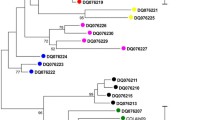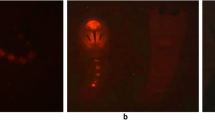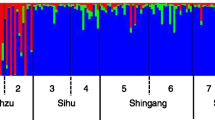Abstract
We conducted mating competitions between wild-type and heterozygous transgenic Anopheles arabiensis males that were produced by repeated backcrosses of a transposable element expressing the β2-tubulin eGFP marker into two genetic backgrounds. These competed for genetically similar or dissimilar females in ratios of 1:1:3. We analyzed the effect of genetic similarity, transgenic state and stock on mating frequency. We observed no differences in the competitiveness of the wild and transgenic heterozygotes, no effect of genetic relatedness, nor a clear benefit of the out-crossing strategy to increase competitiveness. A decrease in the development rate of all phenotypic classes was observed among progeny of transgenic males but the rate of adult emergence of transgenic individuals was in most cases slightly faster than wild-type siblings.



Similar content being viewed by others
References
Baker RH, Reisen WK, Sakai RK, Hayes CG, Aslamkhan M, Saifuddin UT, Mahmood F, Perveen A, Javed S (1979) Field assessment of mating competitiveness of male Culex tritaeniorhynchus carrying a complex chromosomal aberration. Ann. Entomol. Soc. Am. 72:751–758
Baker RH, Reisen WK, Sakai RK, Rathor HR, Raana K, Azra K, Niaz S (1980) Anopheles culicifacies: mating behavior and competitiveness in nature of males carrying a complex chromosomal aberration. Ann. Entomol. Soc. Am. 73:581–588
Bartlett AC (1984) Genetic changes during insect domestication. In: King EG, Leppla NC (eds) Advances and Challenges in Insect Rearing. Agricultural Research Service, New Orleans, pp 2–8
Bock ME, Reisen WK, Milby MM (1983) Lifetime mating pattern of laboratory-adapted Culex tarsalis males. Mosq. News. 43:350–354
Bush GL, Neck RW, Kitto GB (1976) Screwworm eradication: inadvertent selection for noncompetitive ecotypes during mass rearing. Science 193:491–493
Catteruccia F (2007) Malaria vector control in the third millennium: progress and perspectives of molecular approaches. Pest Manag. Sci. 63:634–640
Catteruccia F, Godfray HCJ, Crisanti A (2003) Impact of genetic manipulation on the fitness of Anopheles stephensi mosquitoes. Science 299:1225–1227
Catteruccia F, Benton JP, Crisanti A (2005) An Anopheles transgenic sexing strain for vector control. Nature Biotech. 23:1414–1417
Cayol JP (2000) Changes in sexual behavior and life history traits of Tephritid species caused by mass-rearing processes. In: Aluja M, Norrbom AL (eds) Fruit Flies (Tephritidae): Phylogeny and Evolution of Behavior. CRC Press, Boca Raton, Florida, pp 843–860
Cayol JP, Coronado P, Taher M (2002) Sexual compatibility in medfly (Diptera: Tephritidae) from different origins. Fl. Entomol. 85:51–57
Dame DA, Woodard DB, Ford HR, Weidhaas DE (1964) Field behavior of sexually sterile Anopheles quadrimaculatus males. Mosq. News. 24:6–14
Ferguson HM, John B, Ng’habi K, Knols BGJ (2005) Redressing the sex imbalance in knowledge of vector biology. Trends Ecol. Evol. 20:202–208
Girod R, Coetzee M, Salvan M, Hunt RH (2001) Polymorphisme chromosomique des populations d’anopheles arabiensis (Diptera: Culicidae) de l’île de la Réunion et inter-fertilité avec des populations d’Afrique continentale. Parassitologia 43:99–103
Helinski MEH, Hassan MM, El-Motasim WM, Malcolm CA, Knols BGJ, El-Sayed B (2008) Towards a sterile insect technique field release of Anopheles arabiensis mosquitoes in Sudan: irradiation, transportation, and field cage experimentation. Malaria J. 7:65
Holt RA et al (2002) The genome sequence of the malaria mosquito Anopheles gambiae. Science 298:129–149
Horn C, Wimmer EA (2003) A transgene-based, embryo-specific lethality system for insect pest management. Nature Biotech 21:64–70
Joslyn DJ (1984) Maintenance of genetic variability in reared insects. In: King EG, Leppla NC (eds) Advances and Challenges in Insect Rearing. Agricultural Research Service, New Orleans, pp 20–29
Kaiser PE, Bailey DL, Lowe RE, Seawright JA, Dame DA (1979) Mating competitiveness of chemosterilized males of a genetic sexing strain of Anopheles albimanus in laboratory and field tests. Mosq. News 39:768–775
Kaneshiro KY (1980) Sexual isolation, speciation and the direction of evolution. Evolution. 34:437–444
Knols BGJ, Njiru BN, Mathenge EM, Mukabana WR, Beier JC, Killeen GF (2002) Malariasphere: a greenhouse-enclosed simulation of a natural Anopheles gambiae (Diptera: Culicidae) ecosystem in western Kenya. Malaria J. 1:19
Lance DR, McInnis DO, Rendon P, Jackson CG (2000) Courtship among sterile and wild Ceratits capitata (Diptera: Tephritidae) in field cages in Hawaii and Guatemala. Ann. Entomol. Soc. Am. 93:1179–1185
Li C, Marrelli MT, Yan G, Jacobs-Lorena M (2008) Fitness of transgenic Anopheles stephensi mosquitoes expressing the SM1 peptide under the control of a vitellogenin promoter. J. Heredity. 99:275–282
Lorimer NL, Louni bos LP, Peterson JL (1976) Field trials with a translocation heterozygote in Aedes aegypti for population replacement. J. Econ. Entomol. 69:405–409
Malcolm CA, Wellsby DA, El Sayed BB (2007) SIT for the malaria vector Anopheles arabiensis in Northern State, Sudan: an historical review of the field site. In: Vreysen MJB, Robinson AS, Hendrichs J (eds) Area-Wide Control of Insect Pests. IAEA, Vienna, pp 361–372
Marelli MT, Moreira CK, Kelly D, Alphey L, Jacobs-Lorena M (2006) Mosquito transgenesis: what is the fitness cost? Trends Parasit. 22:197–202
McDonald, P.T. (1979). Effects of laboratory colonization on the reproductive abilities of a field-collected Culex tarsalis population. Proc. Pap. 47th Annual Conf. Calif. Mosq. Vect. Control Assoc. pp. 60–61.
Menge DM, Guda T, Zhong D, Pai A, Zhou G, Beier JC, Gouagna L, Yan G (2005) Fitness consequences of Anopheles gambiae population hybridization. Malaria J. 4:44
Moreira LA, Wang J, Collins FH, Jacobs-Lorena M (2004) Fitness of anopheline mosquitoes expressing transgenes that inhibit Plasmodium development. Genetics. 166:1337–1341
Nunney L (2003) Managing captive populations for release: a population genetic perspective. In: van Lenteren JC (ed) Quality Control and Production of Biological Control Agents: Theory and Testing Procedures. CAB International, Wallingford, UK, pp 73–88
Orozco-Davila D, Hernandez R, Meza S, Dominguez J (2007) Sexual competitiveness and compatibility between mass-reared sterile flies and wild populations of Anastrepha ludens (Diptera: Tephritidae) from different regions in Mexico. Fl. Entomol. 90:19–26
Pates H, Curtis C (2005) Mosquito behavior and vector control. Ann. Rev. Entomol. 50:53–70
Petersen JL, Lounibos LP, Lorimer N (1977) Field trials of double translocation heterozygote males for genetic control of Aedes aegypti (L.) (Diptera: Culicidae). Bull. Entomol. Res. 67:313–324
Reisen WK, Bock ME, Milby MM, Reeves WC (1985) Attempted insertion of a recessive autosomal gene into a semi-isolated population of Culex tarsalis (Diptera: Culicidae). J. Med. Entomol. 22:250–260
Reisen WK, Sakai RK, Baker RH, Rathor HR, Raana K, Azra K, Niaz S (1980) Field competitiveness of Culex tritaeniorhynchus Giles males carrying a complex chromosomal aberration: a second experiment. Ann. Entomol. Soc. Am. 73:479–484
Rowland M (1991) Activity and mating competitiveness of γHCH/dieldrin resistant and susceptible male and virgin female Anopheles gambiae and An. stephensi mosquitoes, with assessment of an insecticide-rotation strategy. Med. Vet. Entomol. 5:207–222
Rutledge LC, Ward RA, Bickley WE (1970) Experimental hybridization of geographic strains of Anopheles stephensi (Diptera: Culicidae). Ann. Entomol. Soc. Am. 63:1024–1030
Savage KE, Lowe RE (1971) A one-piece aluminum cage designed for adult mosquitoes. Mosq. News 31:111–112
Weidhaas DE, Breeland SG, Lofgren CS, Dame DA, Kaiser R (1974) Release of chemosterilized males for the control of Anopheles albimanus in El Salvador IV. Dynamics of the test population. Am. J. Trop. Med. Hyg. 23:298–308
Acknowledgements
We appreciate the NIAID-funded contract N01-AI-85355 to the American Type Culture Collection and and its financial support in the operation of the MR4 and their cooperation in developing and implementing the subcontract to the CDC Foundation that makes this research possible. Special thanks to the donors of the mosquito stocks; without them these experiments would not have been possible: Maureen Coetzee (KGB), Badria Babiker El Sayed (DONGOLA), Hervé Bossin and Janis Thailayil (DONG-GFP+).
Author information
Authors and Affiliations
Corresponding author
Rights and permissions
About this article
Cite this article
Howell, P.I., Benedict, M.Q. Mating Competitiveness of Anopheles arabiensis Males as a Function of Transgenic State and Genetic Similarity to Females. J Insect Behav 22, 477–491 (2009). https://doi.org/10.1007/s10905-009-9187-y
Revised:
Accepted:
Published:
Issue Date:
DOI: https://doi.org/10.1007/s10905-009-9187-y




